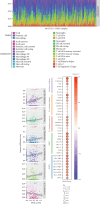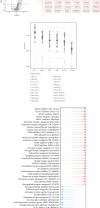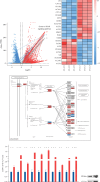Clinical Relevance and Drug Modulation of PPAR Signaling Pathway in Triple-Negative Breast Cancer: A Comprehensive Analysis
- PMID: 39735727
- PMCID: PMC11681981
- DOI: 10.1155/ppar/4164906
Clinical Relevance and Drug Modulation of PPAR Signaling Pathway in Triple-Negative Breast Cancer: A Comprehensive Analysis
Abstract
Triple-negative breast cancer (TNBC) is highly heterogeneous and poses a significant medical challenge due to limited treatment options and poor outcomes. Peroxisome proliferator-activated receptors (PPARs) play a crucial role in regulating metabolism and cell fate. While the association between PPAR signal and human cancers has been a topic of concern, its specific relationship with TNBC remains unclear. Integrated analysis of large published datasets from clinical cohorts and cell lines through databases has proven to be a powerful and essential approach for understanding cancer and uncovering new molecular targets. Here, we conducted a comprehensive study investigating the clinical relevance and drug modulation of the PPAR signaling pathway in TNBC, using data from The Cancer Genome Atlas (TCGA) for TNBC patients and Genomics of Drug Sensitivity in Cancer (GDSC) for TNBC cell lines, along with drug perturbation information from Connectivity Map (CMap). In the TCGA-TNBC cohort, higher PPAR signaling activity was not associated with clinical stage, prognosis, tumor mutational burden, microsatellite instability, homologous recombination deficiency, stemness, or proliferation status. However, it was linked to older age; an elevated rate of piccolo presynaptic cytomatrix protein (PCLO) mutations; and oncogenic signal transduction involving MAPK, Ras, and PI3K-Akt pathways. Additionally, it influenced biological pathways including fatty acid metabolism, AMPK signaling, and ferroptosis. Strikingly, higher PPAR activity appeared to promote the formation of an antitumor immune and microbial microenvironment. In the GDSC-TNBC cells, nevertheless, it seemed to incur chemoresistance. Furthermore, we identified a batch of potential compounds that can regulate the PPAR signaling pathway. Lastly, our experimental validation demonstrated the ability of the histone deacetylase (HDAC) inhibitor chidamide to activate the PPAR signal in TNBC cells. In conclusion, the PPAR signaling pathway likely has pleiotropic biological effects in TNBC. These preliminary but interesting findings enhance our understanding of the role played by PPAR signal and provide new insights into the heterogeneity driven by it in TNBC.
Copyright © 2024 Yanxia Zhang et al.
Conflict of interest statement
The authors declare no conflicts of interest.
Figures






Similar articles
-
Comprehensive characterization of fatty acid oxidation in triple-negative breast cancer: Focus on biological roles and drug modulation.Eur J Pharmacol. 2025 Mar 15;991:177343. doi: 10.1016/j.ejphar.2025.177343. Epub 2025 Feb 1. Eur J Pharmacol. 2025. PMID: 39900330
-
MIR4435-2HG: A novel biomarker for triple-negative breast cancer diagnosis and prognosis, activating cancer-associated fibroblasts and driving tumor invasion through EMT associated with JNK/c-Jun and p38 MAPK signaling pathway activation.Int Immunopharmacol. 2024 Dec 5;142(Pt B):113191. doi: 10.1016/j.intimp.2024.113191. Epub 2024 Sep 23. Int Immunopharmacol. 2024. PMID: 39317050
-
Multiomics analysis reveals the involvement of NET1 in tumour immune regulation and malignant progression.Sci Rep. 2025 Jan 2;15(1):56. doi: 10.1038/s41598-024-83714-8. Sci Rep. 2025. PMID: 39747410 Free PMC article.
-
Impact of microRNA variants on PI3K/AKT signaling in triple-negative breast cancer: comprehensive review.Med Oncol. 2024 Aug 9;41(9):222. doi: 10.1007/s12032-024-02469-4. Med Oncol. 2024. PMID: 39120634 Review.
-
The signaling pathways and targets of traditional Chinese medicine and natural medicine in triple-negative breast cancer.J Ethnopharmacol. 2021 Jan 10;264:113249. doi: 10.1016/j.jep.2020.113249. Epub 2020 Aug 15. J Ethnopharmacol. 2021. PMID: 32810619 Review.
References
LinkOut - more resources
Full Text Sources

